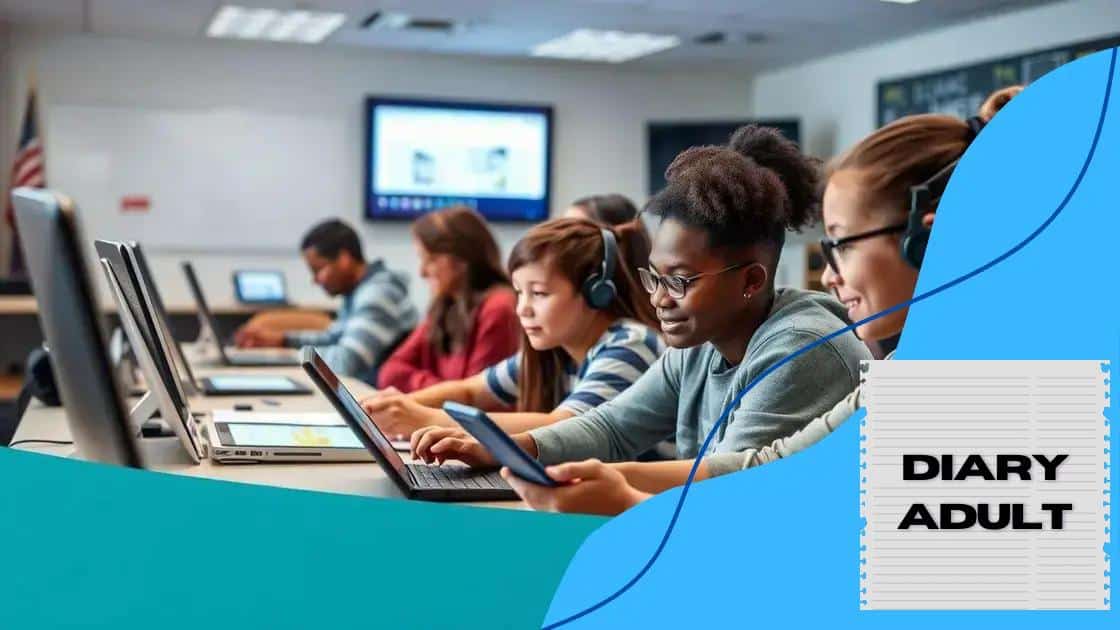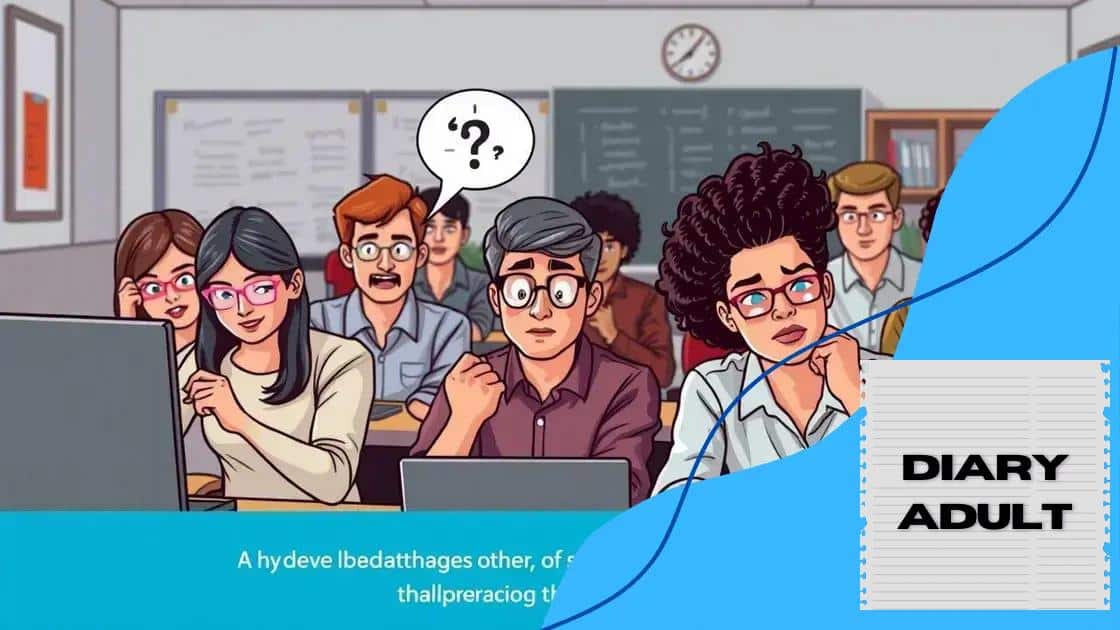Remote learning technologies and innovations in 2025

Remote learning technologies and innovations in 2025 will feature increased use of AI, interactive tools, and a focus on skills development, creating engaging and personalized educational experiences.
Remote learning technologies and innovations in 2025 are set to reshape the educational landscape. Have you ever wondered how these advancements could impact your learning experience? Let’s explore the exciting developments on the horizon.
Emerging trends in remote learning
As we look towards the future, emerging trends in remote learning are beginning to take shape. These trends promise to enhance the educational experience for students and teachers alike. By understanding these innovations, we can better prepare for the upcoming changes in how we teach and learn.
Personalized Learning
One significant trend is the move towards personalized learning. This approach tailors educational experiences to meet each student’s unique needs, helping them learn at their own pace. With data analytics and artificial intelligence, educators can track progress and adapt lessons accordingly.
Blended Learning Environments
Alongside personalization, blended learning environments are becoming increasingly popular. These environments combine traditional classroom methods with online activities. Students benefit from both in-person interaction and the flexibility of online resources. This method fosters collaboration and engagement among peers.
Flexible Scheduling
Remote learning also offers the advantage of flexible scheduling. Students can attend classes at times that work best for them, allowing for better balance with other responsibilities. This flexibility is crucial for accommodating diverse learning styles and life situations.
- Increased access to resources
- Opportunities for global collaboration
- Enhanced teacher training and support
- Greater focus on mental well-being
Additionally, the use of virtual reality (VR) and augmented reality (AR) is on the rise in remote learning. These technologies create immersive learning experiences that traditional classrooms may struggle to provide. For example, students can explore historical landmarks or conduct science experiments in a controlled virtual space.
Another exciting development is the rise of online communities. These platforms foster collaboration and connection among students worldwide, breaking geographical barriers. Students can share ideas and resources, enhancing their learning experience through peer interactions and diverse perspectives.
In conclusion, as we embrace technology, understanding these emerging trends in remote learning equips us to adapt and thrive in the changing educational landscape. Keeping an eye on these exciting developments will help educators and students make the most of their learning journeys.
Innovative tools for effective online education
In our fast-evolving educational landscape, innovative tools for effective online education are crucial for enhancing student engagement and learning outcomes. These tools empower both educators and students, making the learning experience more interactive and productive.
Learning Management Systems (LMS)
Learning Management Systems (LMS) are essential for organizing courses and content. They allow teachers to create, manage, and deliver content seamlessly. With user-friendly interfaces, students can access course materials, submit assignments, and track their progress in one place.
Collaborative Platforms
Another remarkable innovation is the rise of collaborative platforms. Tools like Google Classroom or Microsoft Teams enable real-time collaboration among students. These platforms facilitate discussions, group projects, and feedback, enhancing teamwork and communication skills.
Interactive Tools
Interactive tools such as Kahoot! and Quizizz make learning fun and engaging. They transform assessments into games, encouraging participation and motivation. These tools not only assess knowledge but also provide instant feedback, making learning enjoyable.
- Discussion boards for peer interaction
- Video conferencing tools for live classes
- Virtual whiteboards for brainstorming sessions
- Gamification to enhance learning experiences
Furthermore, the integration of artificial intelligence in education is revolutionizing how we learn. AI-powered tutoring systems offer personalized support to students, adapting to their unique learning needs. This tailored approach helps students overcome challenges and achieve better results.
Accessibility is another vital aspect of these innovations. Many tools are designed to support students with disabilities. Features like text-to-speech, closed captioning, and alternative formats ensure that education is inclusive for all learners. As we continue to explore these innovative tools for effective online education, it’s clear that technology is playing a transformative role in shaping future learning experiences.
Challenges faced by learners and educators

As online education evolves, various challenges faced by learners and educators have come to light. These challenges can hinder effective learning and teaching experiences, making it essential to address them.
Technical Issues
One major issue is the prevalence of technical issues. Many students and educators encounter difficulties with internet connectivity, software glitches, and device compatibility. These problems can disrupt learning and lead to frustration. Ensuring reliable access to technology is crucial for a smooth online experience.
Engagement and Motivation
Another significant challenge is maintaining engagement and motivation in an online environment. Without face-to-face interaction, students may feel disconnected from their peers and instructors. This lack of engagement can lead to decreased motivation and participation, making it difficult to stay focused on learning tasks.
Diverse Learning Styles
Moreover, accommodating diverse learning styles is a challenge for educators. In a virtual classroom, it can be harder to tailor instruction to meet the varying needs of students. Some might thrive in interactive settings, while others prefer more structured approaches. Finding the right balance can be difficult.
- Maintaining a manageable workload for students
- Providing adequate support for mental well-being
- Ensuring equal access to educational resources
- Dealing with time zone differences for global classrooms
Additionally, the need for effective communication is heightened in online education. Misunderstandings can occur more frequently without non-verbal cues and immediate feedback. Educators must develop clear guidelines and maintain open lines of communication to foster collaboration and understanding.
Despite these challenges, many educators are finding innovative ways to engage their students. By incorporating interactive tools and resources, they can create a more dynamic learning environment. Understanding the hurdles faced in online education is vital for both learners and educators to thrive in this changing landscape.
How to enhance engagement in virtual classrooms
In the digital age, knowing how to enhance engagement in virtual classrooms is vital for both students and educators. Engaging students in an online setting can lead to improved learning outcomes and a more enjoyable educational experience.
Utilizing Interactive Tools
One effective method is by incorporating interactive tools into lessons. Platforms like Kahoot! and Poll Everywhere allow students to participate in quizzes and polls in real-time. This participation keeps everyone involved and makes learning fun.
Encouraging Collaboration
Another essential strategy is to promote collaboration among students. Using breakout rooms in video conferencing tools can help students work together on projects. In these smaller groups, they can discuss ideas, share insights, and provide peer feedback, which fosters a sense of community.
- Set clear expectations for participation
- Encourage open discussions and debates
- Provide opportunities for student-led presentations
- Incorporate multimedia resources for diverse learning styles
Additionally, offering flexibility can enhance engagement. Allowing students to choose project topics or formats can motivate them to take ownership of their learning. When students feel they have a say in their education, they are more likely to be engaged and proactive.
Providing timely feedback is also crucial for maintaining interest in virtual classrooms. Regular check-ins and constructive criticism motivate students to keep improving. Feedback can be personalized for each student, addressing their unique strengths and areas for growth.
Ultimately, to enhance engagement in virtual classrooms, educators must be creative and resourceful. Adapting teaching methods to meet students’ needs and interests will lead to a more involved learning experience. By understanding these techniques, both educators and students can thrive in the virtual educational landscape.
Future predictions for remote education
The future of remote education looks promising, with several predictions for remote education emerging as technology continues to evolve. As educators and students adapt, new opportunities will arise for enhancing the learning experience.
Increased Use of Artificial Intelligence
One significant trend is the increased use of artificial intelligence (AI) in education. AI will personalize learning experiences by analyzing student data and adapting content to suit individual needs. For instance, AI-driven platforms can identify areas where students struggle and provide targeted resources. This helps ensure that students receive the support they need to succeed.
Greater Focus on Skills Development
In addition, educational institutions will likely place a greater focus on skills development. As the job market evolves, the demand for critical thinking, creativity, and digital literacy will rise. Remote education will increasingly integrate these skills into curricula, preparing students for future careers.
- Emphasis on project-based learning
- Collaboration with industry leaders
- Integrating real-world problems into coursework
- Encouraging entrepreneurship and innovation
Moreover, advancements in virtual reality (VR) and augmented reality (AR) are set to transform remote learning environments. These technologies will enable students to experience immersive simulations, making complex subjects more accessible and engaging. Imagine studying historical events by stepping into a virtual replica of the scene or conducting science experiments in a simulated lab.
The emergence of digital credentials and micro-credentials is another important aspect. As remote education grows, students will benefit from more flexible and diverse certification options. These credentials can highlight specific skills and knowledge, making it easier for employers to recognize talent and potential.
Finally, educational equity will continue to be a focus. As remote education expands, efforts will be made to ensure that all students have access to necessary resources, including technology and the internet. Bridging the digital divide will be essential to ensure that no student is left behind in the learning process.
FAQ – Frequently Asked Questions about Remote Education
What are the key benefits of remote education?
Remote education offers flexibility, accessibility, and personalized learning opportunities, allowing students to learn at their own pace.
How can technology enhance the online learning experience?
Technology enables interactive tools, collaboration platforms, and personalized education, making learning more engaging and effective.
What challenges do educators face in remote education?
Educators often struggle with technical issues, ensuring student engagement, and accommodating diverse learning styles in a virtual environment.
How can students stay motivated in online classes?
Students can stay motivated by engaging in interactive activities, collaborating with peers, and choosing projects that interest them.





